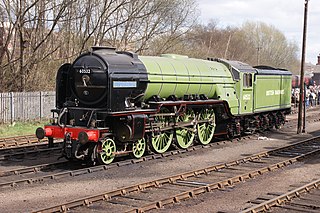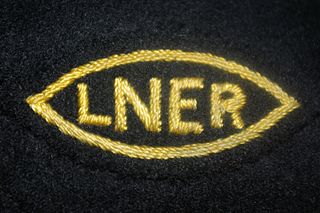This page is based on this
Wikipedia article Text is available under the
CC BY-SA 4.0 license; additional terms may apply.
Images, videos and audio are available under their respective licenses.

The London and North Eastern Railway (LNER) Peppercorn Class A1 is a type of express passenger steam locomotive. Forty-nine original Peppercorn Class A1s were built to the design of Arthur Peppercorn during the early British Railways era, but all were scrapped with the discontinuation of steam, with none of the original production run surviving into preservation. In 2008, a brand new 50th Peppercorn A1 locomotive, 60163 Tornado, was completed.

Arthur Henry Peppercorn, was an English railway engineer, and was the last Chief Mechanical Engineer (CME) of the London and North Eastern Railway.

The North Eastern Railway Class S3, classified B16 by the LNER, was a class of 4-6-0 steam locomotive designed for mixed traffic work. It was designed by Vincent Raven and introduced in 1920. The earlier members of this class were fitted with Westinghouse Brakes - all of this equipment was removed during the 1930s.

The London and North Eastern Railway (LNER) Thompson Class O1 was a class of 2-8-0 steam locomotive designed by Edward Thompson for freight work. None have survived to preservation.

The Great Northern Railway Class H4 was a class of 2-6-0 steam locomotive designed for mixed-traffic work.
Edward Thompson was an English railway engineer, and was Chief Mechanical Engineer of the London and North Eastern Railway between 1941 and 1946. Edward Thompson was born at Marlborough, Wiltshire on 25 June 1881. He was the son of an assistant master at Marlborough College. He was educated at Marlborough before taking the Mechanical Science Tripos at Pembroke College, Cambridge, earning a third class degree. Thompson's academic background contrasts with that of his predecessor Nigel Gresley, who had also attended Marlborough, but then gained practical experience as a pupil at Horwich Works.

The London and North Eastern Railway (LNER) Class B17, also known as "Sandringham" or "Footballer" class was a class of 4-6-0 steam locomotive designed by Nigel Gresley for hauling passenger services on the Great Eastern Main Line. In total 73 were built.
The London and North Eastern Railway (LNER) Thompson Class Q1 was a class of 0-8-0T steam locomotives. They were rebuilds of the GCR Class 8A 0-8-0s. Thirteen were rebuilt between 1942 and 1945. All passed to British Railways in 1948, numbered 69925-69937. The sources for the information in the infobox (right) are.

The London and North Eastern Railway (LNER) Thompson Class B2 was a class of 4-6-0 steam locomotive. It was introduced in 1945 as a two-cylinder rebuild of the three-cylinder LNER Class B17. Ten were rebuilt from Class B17 but no more were rebuilt because of the success of the LNER Thompson Class B1.

The first London and North Eastern Railway (LNER) Class A2 was a class of 4-6-2 steam locomotive designed by Vincent Raven for the North Eastern Railway. Two were built by the NER in 1922 before the grouping and another three by the LNER in 1924. Their LNER numbers were 2400–2404. All five locomotives were named by the LNER.

The London and North Eastern Railway (LNER) Class K1 is a type of 2-6-0 (mogul) steam locomotive designed by Edward Thompson. Thompson preferred a simple two-cylinder design instead of Gresley's three cylinder one. The seventy K1s were intended to be split between the North Eastern Region of British Railways and the Eastern Region of British Railways.

The London and North Eastern Railway Class V4 was a class of 2-6-2 steam locomotive designed by
Sir Nigel Gresley for mixed-traffic use. It was Gresley's last design for the LNER before he died in 1941. The V4s had similarities in their appearance and mechanical layout to the V2 "Green Arrow" class. The V2s, introduced some years before, were large and heavy locomotives, with very limited route availability. The V4 was a lightweight alternative, suitable for use over the whole of the LNER network.

The LNER Class A1/1 consisted of a single 4-6-2 "Pacific" express passenger locomotive rebuilt in 1945 from an A1 class locomotive, by Edward Thompson. It was intended as the prototype of a new design of pacific locomotives improving the A4 design of Thompson’s predecessor Sir Nigel Gresley. No further examples were built due to Thompson’s retirement in 1946.
Willie Brayshaw Yeadon, was a British railway historian known for his magnum opus, Yeadon's Register of LNER Locomotives and other works.

The London and North Eastern Railway (LNER) Thompson Class A2/1 was a class of 4-6-2 steam locomotives built at Darlington locomotive works during 1944. They were originally ordered as Class V2 locomotives, as designed by Sir Nigel Gresley, but were revised during construction into a 4-6-2 'Pacific' arrangement under the instruction of Edward Thompson.

The London and North Eastern Railway (LNER) Class A2/3 was a class of 4-6-2 steam locomotives. They were newly constructed locomotives, fulfilling the requirement identified by Edward Thompson for a standard express passenger locomotive of the 4-6-2 arrangement with 6 ft 2 in (1.880 m) driving wheels. Fifteen engines were constructed according to this original design, but following the retirement of Thompson as CME, the remaining fifteen locomotives that were planned were immediately redesigned and ultimately emerged as Peppercorn Class A2.

The GCR Class 9Q, classified B7 by the LNER, was a class of 4-6-0 mixed traffic locomotives designed by John G. Robinson for fast goods, relief passenger and excursion services on the Great Central Railway. They were a smaller wheeled version of Robinson’s earlier Class 9P "Lord Faringdon" express passenger class.
GCR Class 9P was a design of four-cylinder steam locomotive of the 4-6-0 wheel arrangement built for hauling express passenger trains on the Great Central Railway in England. A total of six were built: one in 1917, and five in 1920. They were sometimes known as the Lord Faringdon class, from the name of the first one built.















